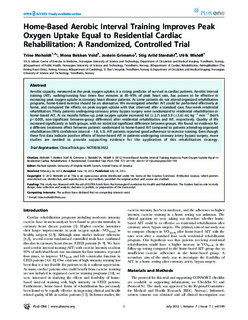Home-Based Aerobic Interval Training Improves Peak Oxygen Uptake Equal to Residential Cardiac Rehabilitation: A Randomized, Controlled Trial
Journal article, Peer reviewed
Permanent lenke
http://hdl.handle.net/11250/2365611Utgivelsesdato
2012Metadata
Vis full innførselSamlinger
Sammendrag
Aerobic capacity, measured as the peak oxygen uptake, is a strong predictor of survival in cardiac patients. Aerobic interval training (AIT), walking/running four times four minutes at 85–95% of peak heart rate, has proven to be effective in increasing peak oxygen uptake in coronary heart disease patients. As some patients do not attend organized rehabilitation programs, home-based exercise should be an alternative. We investigated whether AIT could be performed effectively at home, and compared the effects on peak oxygen uptake with that observed after a standard care, four-week residential rehabilitation. Thirty patients undergoing coronary artery bypass surgery were randomized to residential rehabilitation or home-based AIT. At six months follow-up, peak oxygen uptake increased 4.6 (±2.7) and 3.9 (±3.6) mL·kg−1 min−1 (both p<0.005, non-significant between-group difference) after residential rehabilitation and AIT, respectively. Quality of life increased significantly in both groups, with no statistical significant difference between groups. We found no evidence for a different treatment effect between patients randomized to home-based AIT compared to patients attending organized rehabilitation (95% confidence interval −1.8, 3.5). AIT patients reported good adherence to exercise training. Even though these first data indicate positive effects of home-based AIT in patients undergoing coronary artery bypass surgery, more studies are needed to provide supporting evidence for the application of this rehabilitation strategy.
